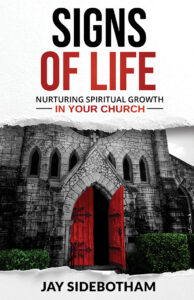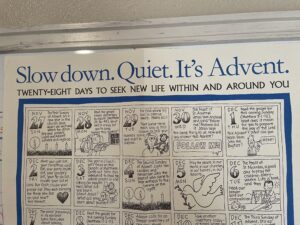 Jay Sidebotham has served as a priest in the Episcopal Church for more than 30 years. He also enjoys creating artwork, including cartoons, reflecting life in the church. Before ordination, he worked in an animation studio that produced Schoolhouse Rock cartoons and then as an art director in several advertising agencies. Some say he is still in advertising.
Jay Sidebotham has served as a priest in the Episcopal Church for more than 30 years. He also enjoys creating artwork, including cartoons, reflecting life in the church. Before ordination, he worked in an animation studio that produced Schoolhouse Rock cartoons and then as an art director in several advertising agencies. Some say he is still in advertising.
Jay is also the founder of RenewalWorks, a ministry seeking to make spiritual growth the priority in Episcopal congregations and to build cultures of discipleship in those congregations. His new book, Signs of Life, draws on what Jay has learned in a decade of doing this work. Learn more about Jay and his work in this author Q&A.
 How did the idea for this book develop?
How did the idea for this book develop?
After 10 years of work with RenewalWorks, I wanted to share what I had learned in the process. Part of my interest in writing was admittedly to help me clarify key learnings from this work, for my own understanding. I also wanted to share what I had seen churches doing to deepen the spiritual lives of the members of their congregations, in the hopes that those insights could be helpful to folks in a time of anxiety about congregational vitality and church decline.
What is your hope for this book?
My love for the church is deep. My respect for those who lead churches (clergy and lay) has only grown over the last ten years. With that hopeful perspective, I hope that by sharing some of what we’ve learned, we can expand the reach of those learnings. While I would love for every church in Christendom to take on the RenewalWorks process, I know that won’t happen. But I believe many of the insights from this work can be helpful to congregations. In this book, I’ve gathered some core principles in one accessible place, so that congregations (and their leaders, lay and clergy) can consider these principles, and perhaps apply them. All of it has as its goal the deepening of a sense of discipleship, as we seek to follow Jesus and be part of his movement in the world.
 You’re well known in the Episcopal world for your prolific cartoons, found on the “Slow down. Quiet.” calendars and elsewhere. How is your creative process different for writing and visual art?
You’re well known in the Episcopal world for your prolific cartoons, found on the “Slow down. Quiet.” calendars and elsewhere. How is your creative process different for writing and visual art?
The novelist Walker Percy described modern people as waiting for news. For me, the creative process, written or visual, is about communicating some useful and even transformative news. At the heart of all creative processes, there’s an idea, a message worth getting across. In my own case, I go with the medium that can best get that message across. I can say some things in a cartoon that I couldn’t say otherwise. At other times, a written reflection is a better way to make a point. I enjoy being able to do both.
Where do you typically write?
Anywhere. No place in particular. That’s why God made laptops.
Do you have a favorite prayer?
That’s a bit like asking if I have a favorite child. One of the prayers that has guided me over the years is a prayer that appears in services for Ordination, the Liturgy for Good Friday and the Easter Vigil. It speaks of the church, and God’s commitment to the church:
O God of unchangeable power and eternal light: Look favorably on your whole Church, that wonderful and sacred mystery; by the effectual working of your providence, carry out in tranquility the plan of salvation; let the whole world see and know that things which were being cast down are being raised up, and things which had grown old are being made new, and that all things are being brought to their perfection by him through whom all things were made, your Son Jesus Christ our Lord; who lives and reigns with you, in the unity of the Holy Spirit, one God, for ever and ever. Amen.
Is there anything else you’d like to share with readers?
Just one more hope for this book, which is that everyone who reads it will see it as a prompt to think about their own spiritual growth. I’m convinced that our congregations will be as spiritually strong and vital as the members of those congregations. My hope then for the church is that every member will explore their own spiritual growth, which we’ve come to understand as growth in love of God and love of neighbor. When that happens, I believe the church will be stronger, living more fully into what God intends, what God is calling us to do and be.
Signs of Life is available on the Forward Movement website. Read a sample or order your copy today.



